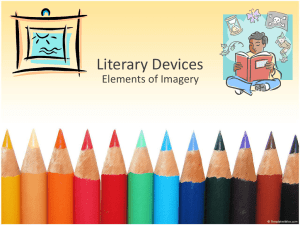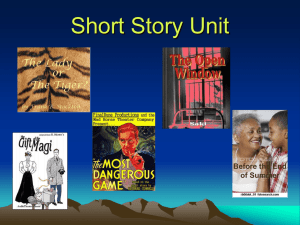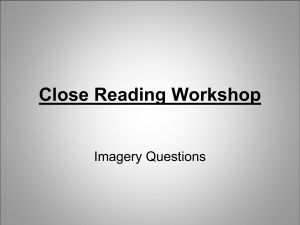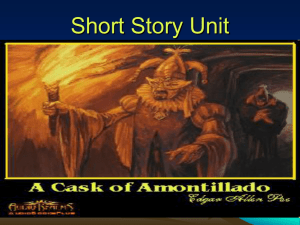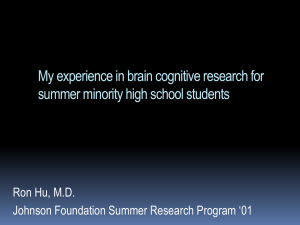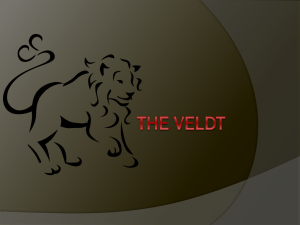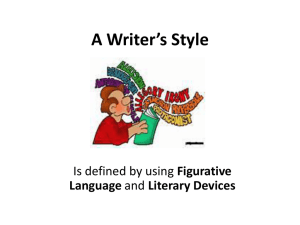Literary Devices PowerPoint
advertisement
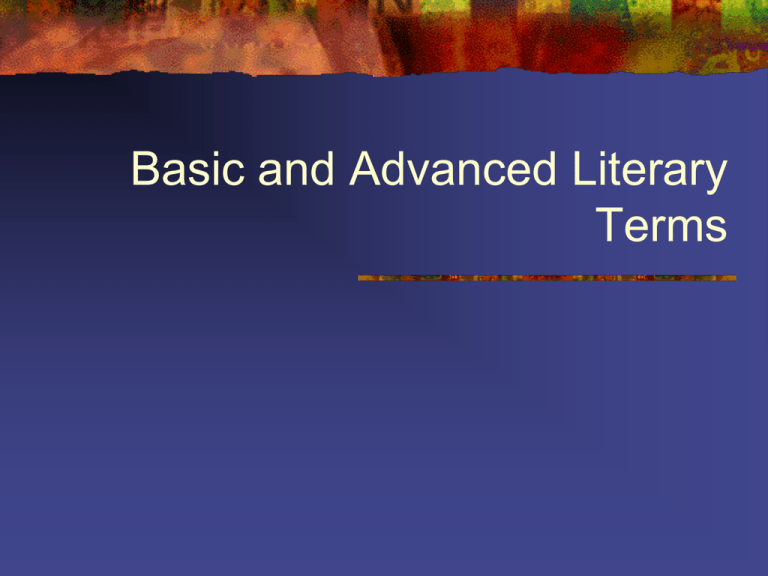
Basic and Advanced Literary Terms Basic Literary Terms The following literary terms are the foundation of skills for understanding literature and analyzing literature. Elements of Plot Plot: the sequence of events in a narrative work. There are basically five stages of plot that you’ll have to know. Elements of Plot (cont.) Exposition: introduces the characters, setting, and conflict. Rising Action: The complications to the conflict and increase the reader’s interest. Elements of Plot (cont.) Climax: The point of greatest emotional intensity, interest, or suspense. The turning point. Falling Action: Follows the climax and shows the results of the climax. Imagery Descriptive language that appeals to the five senses. There are five types of imagery you need to know… Imagery (cont.) Visual Imagery Imagery that deals with picturing something. Example: The dark, black cloud began to block the azure, blue sky as we sat and watched on the beach. Auditory Imagery Imagery that deals with sound and hearing. Example: The doorbell rang and Rayna screamed, “I’ll get it!” Imagery (cont.) Olfactory Imagery Imagery that represents a smell. Example: The garbage can released an odor of rancid, three-week-old milk. Gustatory Imagery Imagery that represents a taste. Example: Mark tasted the briny, bitter salt water for the first time. Imagery (cont.) Tactile Imagery Imagery that represents touch. Example: She dug her toes in the wet sand, but she was still sweating from the hot sun. Tone An author’s attitude toward his or her subject matter. We can figure out tone by an author’s word choice, punctuation, sentence structure, and figures of speech. SAMPLE TONE WORDS: sympathetic, serious, ironic, sad, bitter, humorous, angry, apologetic, critical, proud Mood The emotional quality of a literary work. How a setting makes the reader feel. Mood is determined by setting, subject matter, and tone. SAMPLE MOOD WORDS: Cheerful, gloomy, bleak, eerie, tense, calm, ominous, uncertain, miserable Elements of Plot (cont.) Resolution: (Denouement) part of the plot that reveals the outcome of the conflict. The story comes to a close. Conflict The struggle between opposing forces in a story. External Conflict A character struggles against some outside force: a person, nature, society, or fate. Internal Conflict The struggle takes place in the character’ mind as he/she is torn between opposing forces. Theme The main idea, message, or lesson of a story. Themes of Romeo and Juliet: One must learn to control his/her emotions. Love takes on many forms. One must be allowed to choose who they marry. Foreshadowing and Flashback Foreshadowing: Clues or hints to prepare readers for events that happen later in a story. Flashback: An interruption of the chronological order of a narrative to describe an event that happened earlier. Hyperbole Hyperbole is an exaggeration used for effect. Examples: I’m so hungry I could eat a horse. I told you a million times! We’re never going to get out of this class! Metaphor A comparison that does NOT use like or as. Examples: Juliet is the sun. He is a beast on the football field. Keep your meat hooks off of that food! There are three types of metaphors you need to know… Metaphor (cont.) Extended Metaphor: A metaphor used throughout an entire story or poem. Example: All the world’s a stage And all the men and women merely players They have their exits and entrances; A And one man in his time plays many parts. Metaphor (cont.) Implied Metaphor- A metaphor that is not direct, but implies a comparison. Examples: Tom Brady was licking his chops whenever he found out he was playing the Broncos and not the Steelers. He really spread his wings whenever he graduated. He soared into his future. Metaphor (cont.) Mixed Metaphor: When more than one metaphor is used and the metaphors imply different things. Example: He flew down the track, ate his competition up, cruised by the last runner, and blew up the finish line. Simile and Personification Simile: A comparison using “like” or “as.” Examples: He is like a beast on the field. He whines like a baby when he has to do work. Personification: An animal, object, force of nature, or idea is given human characteristics. Example: The house glanced darkly at him. The sun smiled down on her. Symbolism The use of any literal person, animal, place, object, or event to represent something on the figurative level. In Romeo and Juliet, the ring is a symbol of their love. In Of Mice and Men the farm house George and Lennie dream of symbolizes hope. Irony A contrast or discrepancy between expectation and reality, or between what is expected and what actually happens. There are three types of irony. Irony (cont.) 1. Situational Irony: The outcome of a situation is the opposite of what’s expected. Example: An ambulance injuring pedestrians. 2. Verbal Irony: A person says one thing but means another. Example: Sarcasm Lennie Small Irony (cont.) 3. Dramatic Irony: The audience or reader knows information that the characters do not know. Example: A “kick me” sign on someone’s back. Point of View The position from which a story is told. There are four types of Point of View you need to know. Point of View (cont.) First Person Point of View One of the characters is telling the story and we get only his/her perspective. I, me, we, us, and our will be used Third Person Limited The narrator is not in the story, and the narrator only focuses on one character’s thoughts. Point of View (cont.) Third Person Omniscient The narrator is not in the story, but we get the thoughts and feelings of all characters. Third Person Objective The narrator is not in the story, but we only get the actions of the characters (no thoughts). Anaphora Repetition of the same word or group of words at the beginning of the line. This royal throne of kings… This earth of majesty… This other Eden… This fortress built… Antithesis A balanced, paralleled structure of contrasting ideas. Examples: It was the best of times; it was the worst of times. Ask not what your country can do for you, but what you can do for your country. Apostrophe Address to something inanimate, usually carrying heavy emotion. Examples: O, my soul, where you stand… Hail to thee, blithe spirit! Assonance Repetition of identical or similar vowel sounds, but usually with different ending consonant sounds. Examples: Lake and fate Produced and abused Hook and took Asyndeton Removed conjunctions to give phrases or groups of words a faster pace. “I came, I saw, I conquered.” Consonance Where the end consonants agree but the preceding vowels are not in agreement. River and ever Heaven and given Up and step Dialect Language or way of speech of a particular region. What’s yinz doin? You betcha Y’all Litote A figure of speech that emphasizes its subject by conscious understatement. Usually states the negative of its opposite. Examples: 1. Not bad = good 2. Little profits = no profits at all. Metonymy The substitution of the name of an object closely associated with a word for itself. The crown = the monarchy The White House announced today = the government Overstatement = Hyperbole Exaggerated overstatement. I’m starving I’m so hungry I can eat a horse. The shot heard round the world. Synecdoche When a part is used to signify the whole. Usually distinguished by the item standing for the whole should be a significant/important part of the whole and directly associated with it. All hands on deck! Nice threads that you have on today. Understatement A figure of speech which defectively falls short of the magnitude of what is being talked about. Litotes, although a form of understatement, work with negative/opposite terminology. "It's just a flesh wound." (Black Knight, after having both of his arms cut off, in Monty Python and the Holy Grail)

